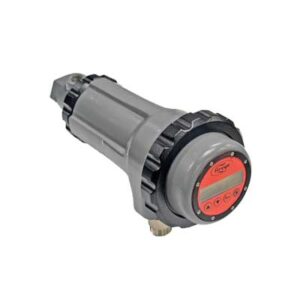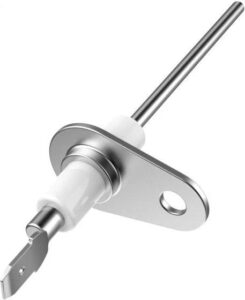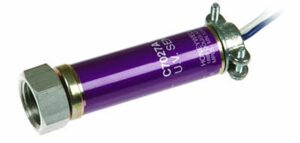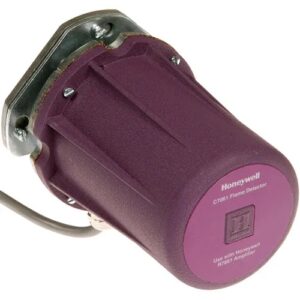What Is a Flame Sensor and How do they operate in furnaces?




How Flame Sensors Work
Types of Flame Sensors
Role of Flame Sensors in System Safety
Maintenance of Flame Sensors
How Does a Flame Sensor Work: Safety Features in Furnaces – FAQs
How Flame Sensors Work
A flame sensor is an important safety device used in heating appliances like furnaces, boilers, and water heaters. Its primary function is to detect the presence of a flame during operation to ensure the combustion process is working correctly. If no flame is detected, the sensor signals the system to shut off the gas supply or fuel supply, preventing potential gas leaks and explosions.
Design and Appearance:
- A flame sensor typically looks like a thin metal rod or large metal cases with a small viewing port. They are often made of durable heat-resistant materials, such as stainless steel or ceramic.
- It is installed in the burner assembly, where its viewing port is positioned in the flame’s path.
- The sensor is connected to the control board of the furnace or boiler via a wire that transmits the flame’s signal (through a low current).
- Most flame sensors use ionization to detect a flame. As the flame burns, ions are produced, which the flame sensor picks up by allowing a small current to flow through the flame. If the current is interrupted, the sensor assumes the flame is out and shuts down the system.
Importance of Flame Detection:
- Safety: The primary role of a flame sensor is safety. If a furnace or boiler’s burner fails to ignite or the flame goes out, unburned gas could continue to flow. The flame sensor stops this by cutting off the gas supply.
- Efficiency: In addition to safety, the flame sensor ensures efficient operation by preventing unnecessary gas usage and signaling when there is a problem in the combustion process, allowing the system to run smoothly.
- Protection: By detecting flame presence, it protects the appliance from malfunctioning or overheating, helping avoid costly repairs and extending the lifespan of the heating system.
Proving the presence of a flame is a critical step in the gas firing process. Without proper flame verification, unburned gas could be released into the heat exchanger, creating a serious risk of explosion.
Types of Flame Sensors
| Type of Flame Sensor | Manufacturer | Example Model | How It Works | Applications | Features |
|---|---|---|---|---|---|
| Ultraviolet (UV) Flame Sensors | Honeywell, Fireye, Siemens | Honeywell C7012A, Fireye 45UV5, Siemens QRA2 | Detects ultraviolet radiation emitted by a flame. | Industrial boilers, furnaces, and burners (oil, gas, coal). | High-speed response, works in harsh, dusty environments. |
| Infrared (IR) Flame Sensors | Honeywell, Fireye, Siemens | Honeywell C7061A, Fireye 45RM4, Siemens QRI | Detects infrared radiation emitted by a flame. | Industrial furnaces, high-temperature environments, oil/coal burners. | Effective in low visibility (dust, smoke), high-temperature conditions. |
| Rectification Flame Sensors (Flame Rods) | Honeywell | Honeywell Q3400A, Siemens QRB1 | Senses flame by converting AC signal to DC. | Residential gas appliances, furnaces, and water heaters. | Simple, cost-effective, reliable for residential applications. |
| Combined UV/IR Flame Sensors* | Fireye, Siemens | Fireye 45FS1, Siemens QRA73 | Combines UV and IR detection technologies. | Large industrial burners, power plants, chemical facilities. | Reduces false alarms, high sensitivity to a wide range of flame types. |
*Also referred to as Dual Scanners and Multi-Spectrum Scanners
https://www.youtube.com/watch?v=AQe82hrApao – Understanding Flame rectification on gas furnaces.
https://www.youtube.com/watch?v=46XM0cD-fsk – Flame scanner / Working Principle
Shop Our UV Flame Detectors and Sensors
Role of Flame Sensors in System Safety
Flame sensors play a critical role in ensuring the safety of industrial temperature control systems, such as furnaces, boilers, and incinerators, by continuously monitoring the presence of a flame during combustion processes. In industrial environments, where precise control of high temperatures is essential, any failure in combustion can lead to dangerous situations, such as gas leaks, explosions, or fires. Flame sensors are responsible for detecting whether the flame is present and functioning correctly. If the sensor does not detect a flame, it sends a signal to the control system, which immediately shuts down the fuel supply to prevent unburned gas from accumulating in the combustion chamber.
In industries such as power generation, petrochemical processing, and heavy manufacturing, the reliability of flame sensors is vital to maintaining both operational efficiency and worker safety. For example, in gas-fired turbines or oil burners, the continuous verification of flame presence ensures the controlled combustion process that prevents overheating, gas buildup, or equipment damage. Furthermore, flame sensors are often integrated with automated safety shutoff systems, minimizing the risk of catastrophic failure.
In addition to safety, flame sensors contribute to the overall efficiency of industrial systems. By accurately detecting flame conditions, they enable precise control of the combustion process, optimizing fuel use and reducing emissions. In essence, flame sensors not only protect against hazardous situations but also ensure the smooth, efficient operation of critical industrial temperature control systems, enhancing both safety and performance.
Flame Sensor in System Safety Main Points:
- Flame sensors continuously monitor the presence of a flame during combustion processes.
- They play a crucial role in preventing gas leaks, explosions, or fires by detecting flame failure.
- If no flame is detected, the sensors signal the control system to shut down the fuel supply.
- Flame sensors are vital in industries like power generation and petrochemical processing for maintaining operational efficiency and safety.
- They are integrated with automated safety shutoff systems, reducing the risk of catastrophic failure.
- Flame sensors help optimize combustion, improving fuel efficiency and reducing emissions.
Maintenance of Flame Sensors
Regular maintenance of flame sensors is essential to ensure efficient and safe operation of heating systems like furnaces and boilers. Over time, flame sensors and viewing ports can accumulate dirt, dust, or carbon deposits, which can reduce their ability to detect flames accurately. Cleaning the sensor or viewing port with a soft cloth or fine sandpaper every 1-2 years can remove these build-ups. It’s also important to check for corrosion or damage, especially in industrial environments. Ensuring proper alignment of the sensor within the flame path is critical, as even slight misalignment can cause faulty readings. Additionally, flame sensors should be tested periodically to verify functionality, often during routine system inspections. Proper maintenance can extend the life of the sensor and prevent unexpected system shutdowns or safety hazards due to undetected flame loss.
Shop Our Industrial Automation & Equipment Parts Gallery
Safety Features in Furnaces – FAQs
- How do I identify a malfunctioning flame sensor?
- Common signs include frequent furnace shutdowns, the burner igniting but quickly shutting off, or the furnace failing to stay lit. A malfunctioning sensor may not detect the flame properly, triggering safety shutdowns.
- What does a flame sensor look like on a furnace?
- A flame sensor typically looks like a thin metal rod or large metal cases with a small viewing port. It’s usually located near the burner assembly where it directly interacts with the flame.
- How often should flame sensors be replaced or maintained?
- Flame sensors should be cleaned every 1-2 years to remove carbon buildup and checked for corrosion. They generally last 3-5 years, but regular maintenance can extend their life.
- Can a flame sensor prevent all types of furnace accidents?
- While a flame sensor prevents many gas-related hazards, such as gas buildup or incomplete combustion, it cannot prevent all furnace accidents, such as mechanical failures or overheating from other causes.
- What are the signs of a failing flame sensor?
- A failing flame sensor may cause the furnace to short cycle, produce inconsistent heating, or trigger a furnace lockout, requiring manual reset before operation.
